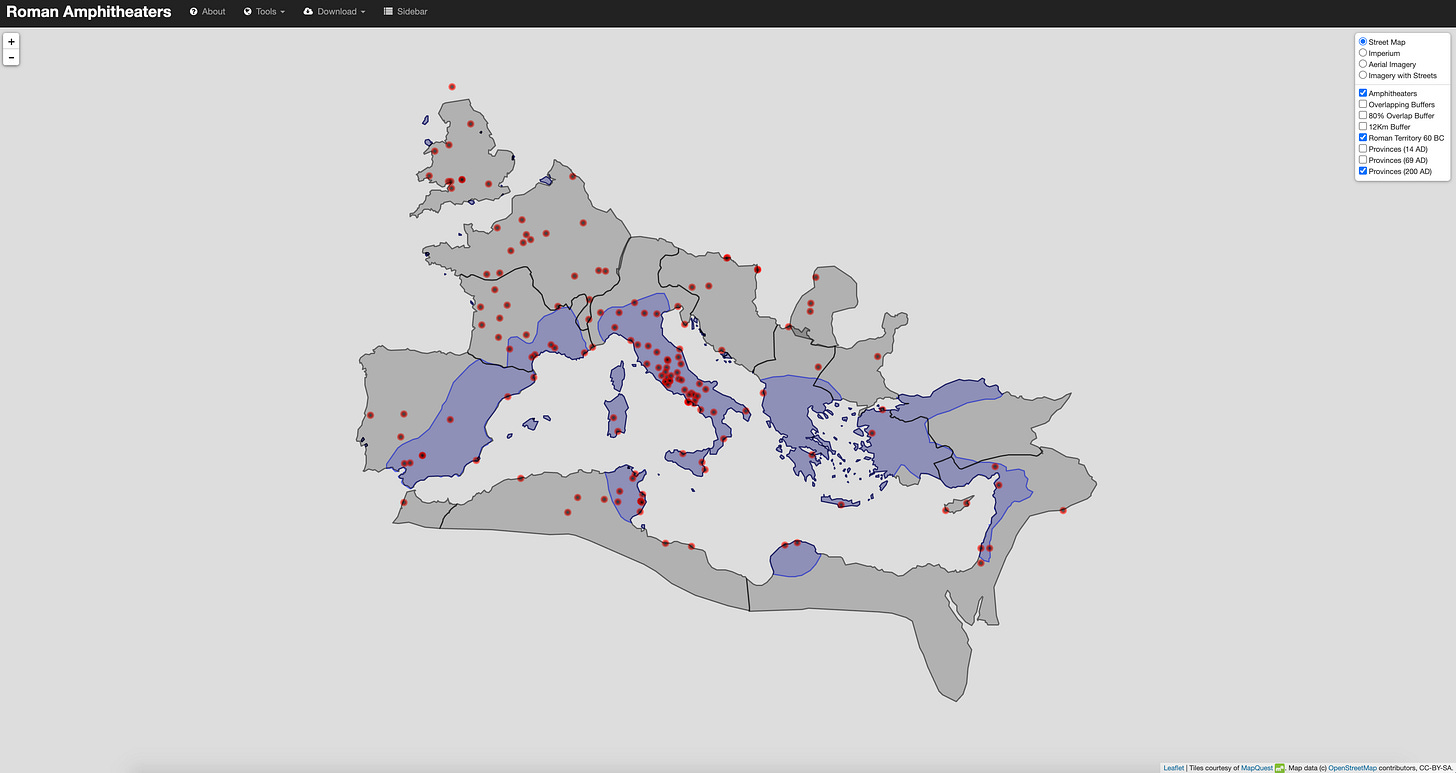
This week, Henry Gruber discusses violence in Late Antiquity and a call for papers on the subject for next year’s AIA-SCS annual meeting in New Orleans. Then, ancient camel hybridization, celebrating Timkat and the Lunar New Year, digital humanities for the ancient world, and more.
Emending Violence in Late Antiquity (Henry Gruber)
For centuries, the period that saw the fall of the Western Roman Empire and the transition to whatever came after was seen as particularly violent. This was a violence primarily driven by the people the Romans called “barbarians,” who poured across the frontiers, pillaging and burning as they went. Histories centered on generals and their exploits. Battles from Adrianople to Yarmuk were seen as decisive turning points, matched only by the brutal sacks of Rome in their import and historical relevance. Over the last fifty or so years, a variant picture of the period ca. 200-700 CE has emerged. This revised imagining of Late Antiquity has rivaled catastrophist views with a narrative that foregrounds transformation, accommodation, and cultural intermingling.
But just because military violence has receded from most narratives of Late Antiquity does not mean that all violence has. In fact, many recent studies underscore different types of violence, and offer a broader and more nuanced understanding of this phenomenon. There was still violence between religious groups, and between the state (in its various configurations) and dissident religious groups, as well as narratives around these forms of violence now seen as crucial to understanding what actually happened in this period and how it was perceived by the people who lived through it. There were also examples of interpersonal and sexual violence glimpsed at in the religious and legal evidence of Late Antiquity, as well as violence exacted against the environment.
At next year’s annual meeting of the Society for Classical Studies (January 2023, New Orleans), the Society for Late Antiquity is organizing a session on “Slow and Fast Violence in Late Antiquity.” We hope to develop a further in dialogue with concepts from outside the field and renewed interest within it. One key concept is that of “Slow Violence,” which modern environmental sociologists have argued shapes and structures contemporary society through pollution, workplace exploitation, and other long tendrils of the global supply chain.
Slow violence in the late antique world includes, but is not limited to landlord-tenant relationships, legal institutions like prisons and mines, as well as slavery in both the domestic and rural sphere. Interrogating this slow violence, as opposed to violence as necessarily fast and presumably military, reopens the question of its experience in Late Antiquity; expanding its definition to include the quotidian violence of social domination in the city and the countryside. We are accepting proposals on any type of late antique violence, for 20-minute papers to be delivered in person in New Orleans. The abstracts are due February 15, 2022 [Full CFP here].
Abbreviated Bibliography
Brown, Peter. The World of Late Antiquity. London: Norton, 1971.
Cooper, Kate, and Jamie Wood, edd. Social Control in Late Antiquity: The Violence of Small Worlds. Cambridge, UK: Cambridge University Press, 2020.
Drake, H. A., ed. Violence in Late Antiquity: Perceptions and Practices. Burlington, VT and Aldershot: Ashgate, 2006
Gaddis, Michael. There Is No Crime for Those Who Have Christ Religious Violence in the Christian Roman Empire. Berkeley: University of California Press, 2005.
Kalleres, Dayna S. City of Demons: Violence, Ritual, and Christian Power in Late Antiquity. Berkeley: University of California Press, 2015.
Nixon, Rob. Slow Violence and the Environmentalism of the Poor. Cambridge, MA: Harvard University Press, 2011.
Riess, Werner, and Garrett G. Fagan, eds. The Topography of Violence in the Greco-Roman World. Ann Arbor: University of Michigan Press, 2016.
Rio, Alice. Slavery After Rome, 500-1100. Oxford: Oxford University Press, 2017.
Shaw, Brent. Sacred Violence: African Christians and Sectarian Hatred in the Age of Augustine. Princeton: Princeton University Press, 2011.
Watts Belser, Julia. “Sex in the Shadow of Rome: Sexual Violence and Theological Lament in Talmudic Disaster Tales,” Journal of Feminist Studies in Religion 30.1 (Spring 2014): 5-24.
Public Scholarship on the Internet
In an open access article, Massimo Vidale, Stefania Berlioz, and Rowaed Mohammed discuss “Iconographic Evidence of Hybridisation between Camelus Bactrianus and Camelus Dromedarius at Second-Century AD Hatra, Iraq” (Antiquity, 2022, 1–8). They examine a sculpted frieze on a lintel of the so-called Temple of Allat at Hatra from the 2ndC CE and interpret the message sent by depicting the hybrid camels publicly:
…[I]t is clear that the two converging lines of camels are led by Camelus bactrianus/dromedarius hybrids. If this is so, the king would have expressed, through the elegant images of the sculpted lintel, both his active support of the cult of the Arab goddess Allat and his personal involvement in the procurement of Bactrian camels from remote Central Asian regions.

It has been a week of celebration across the world. At the Library of Congress, Anchi Hoh looks at “Epiphany and Timkat in Ethiopia: The City of Gondar Hosts Annual Epiphany Celebrations.” Timkat is held on January 19, and “is the Ge’ez expression for the traditional celebration of Epiphany, commemorating the baptism of Jesus Christ in the hands of John the Baptist at River Jordan.” And on February 1, celebration of the Lunar New Year also commenced. Over at Columbia University, they have a short rundown of the ancient history of the Chinese calendar. We are hopeful that the year of the Tiger will give us resilience and strength.
Within The Chronicle of Higher Education, Chris Celenza discusses “paranoia, philology, and the future of the university.” The Dean and former Director of the American Academy in Rome addresses his new book, The Italian Renaissance and the Origins of the Modern Humanities, and what the development of humanistic study in the Renaissance can teach us about the current moment.
On the epigraphy front, the Kalamalla inscription (the first one written entirely in the Telugu language) which dates to 575 CE, was reportedly unearthed on the premises of the Chennakesava-Siddeshwara temple in Yerraguntla Mandal.

In digital humanities news, a number of research databases have been updated recently or perhaps just deserve a bit more traffic:
Sebastian Heath has updated his interactive map of Roman amphitheaters to include the new late antique one discovered in Switzerland (look within the CSV file).
Not enough people are aware of Koen Verboven’s impressive Ghent Database of Roman Guilds, but it is quite useful for investigating the history and epigraphic evidence for ancient voluntary associations often called collegia, thiasoi, societates, etc. The labor union has a long and interesting past.
The Leuven Database of Ancient Books (LDAB) has been updated: “The LDAB database attempts to collect the basic information on all ancient literary texts, as opposed to documents, not only in Latin and Greek, but in all ancient languages. Cuneiform is not yet covered, nor are the Egyptian Books of the Dead. At present, it includes 16916 items, dating from the fourth century B.C. to A.D. 800 and incorporating authors from Homer (8th cent. B.C.) to Romanus Melodus and Gregorius the Great (6th cent. A.D.), including 3671 texts of which the author is unknown.”
February is Black History Month and yesterday marked the launch of the African American Midwest site. You can move topically or state-by-state to explore the long history of African Americans in the American Midwest.

Upcoming Conferences and Lectures
Nicola Denzey Lewis will be speaking virtually on February 20, 2022 at 1 pm EST for the International Catacomb Society. Sign up here.


New Online Journal Issues curated by @YaleClassicsLib
Vivarium Vol. 60, No. 2 (2022) NB: Tamer Nawar, “The Roots of Occasionalism? Causation, Metaphysical Dependence, and Soul-Body Relations in Augustine.”
Vetus Testamentum Vol. 72, No. 1 (2022)
Phronesis Vol.67, No. 1 (2022)
Forum Classicum No. 4 (2021) #openaccess
Avar: An Interdisciplinary Journal of Life & Society in the Ancient Near East Vol. 1, No. 1 (2022) #openaccess Deviance in the Ancient Near East
Journal of Biblical Literature Vol.140, No.4 (2021) Forum on Social Inclusion and the Ethics of Citation
Journal of the History of Philosophy Vol. 60, No. 1 (January 2022)
Vigiliae Christianae Vol.76, No. 1 (2022)
Comparative Oriental Manuscript Studies Bulletin Vol. 7, No. 1 & 2 (2021) #openaccess NB: Drew Longacre, “Comparative Hellenistic & Roman Manuscript Studies (CHRoMS): Script Interactions & Hebrew/Aramaic Writing Culture”
Zephyrvs Vol. 88 (2021) #openaccess
Getty Research Journal Vol. 15 (2022)
Religion in the Roman Empire Vol 7, No. 2 (2021) An Urban Archaeology of Ancient Religion
Early Christianity Vol. 12, No. 4 (2021)
Grecorromana: Revista Chilena de Estudios Clásicos No. 3 (2021) #openaccess
Revista Historias del Orbis Terrarum No. 27 (2021) #openaccess
Pitches
The Public Books section "Antiquities" continues to take pitches for articles to be published in 2022. You can pitch to our “Pasts Imperfect” column at the LA Review of Books using this form and to the new JSTOR column here. Thanks for reading!










